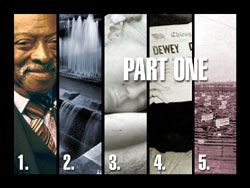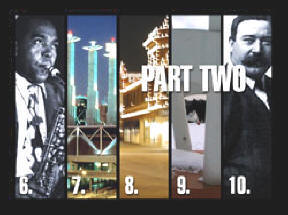
$12.00 (incl. s&h within the U.S.)
…”Talley takes you through a collage of jazz selections dedicated to the sights and sounds that make Kansas City what it is (and was).”
Rod McBride, JAM Magazine
Talley’s colorful approach to the Suite is to be admired. Kansas City Suite is entertaining, exciting and perfectly rendered. I love this album!
Richard Bourcier, JazzReview.com
Liner Notes
The Kansas City Suite, by Doug Talley, is a multi-movement jazz ensemble work for saxophones and rhythm section of acoustic bass, piano and drums. Intended as a “set” for concert performances, the rhythmic feels, tempos and harmonic language are widely varied. The suite presents the jazz quartet in varied textures and combinations with extended periods of improvisation. Approximately 90 minutes in length, the suite is inspired by the following Kansas City landmarks or historical figures:

I. Basie and the Prez
Pianist and band leader Bill “Count” Basie and saxophonist Lester “Prez” Young were two major figures on the Kansas City jazz scene in the 1930’s. This movement captures the feel of classic “Kansas City swing.” Though the tempo may be somewhat fast, the music itself is fairly simple. The melody is based on a riff, or recurring melodic idea, in this case played over a chord progression borrowed from George Gershwin’s “I Got Rhythm.” You might notice that occasionally the piano part will lapse into an older jazz feel known as stride, in which the left hand will jump between bass notes and chords.
II. City of Fountains
Italian composer Ottarino Resphighi immortalized the fountains of Rome in his classical symphonic suite of the same title. Kansas City is known as “The City of Fountains”, and this movement features and elegant, relaxed melody flowing through major tonalities. Borrowing stylistically from 1970’s jazz of the ECM record label, this movement features primarily consonant harmonies with simple-metered rhythms. Though there are a few surprises, such as an introduction and coda in 3/4 time while the body is in 4/4, the mood might be remind the listener of a leisurely afternoon in the park.
III. The Sleeping Child
The Country Club Plaza is one of the most distinctive and unique parts of the city. Dotted with statuary, one of my favorite sculptures is a small, peaceful figure of a reclining sleeping child, posed with head resting on hands. Placed incongruously on a 47th Street median, traffic hurries by day and night, seemingly oblivious to the beauty of this almost-hidden treasure. This movement is a ballad, with a lyrical tenor saxophone melody moving gracefully through unexpected harmonies supplied by the bass and piano. The listener might detect the plagal “amen” cadence at the conclusion of the movement.
IV. The Buck Stops Here
President Harry Truman, a native Missourian, is still revered in the Kansas City area. This lively movement in C minor begins with back beats (beats 2 and 4 in 4/4 time) initiated by the rhythm section. The primary melody, a jagged ascending line, is introduced by the saxophone and repeated with piano accompaniment. The listener will be treated to numerous abrupt changes in tempo, style, texture and tonality in this roller coaster ride to the finish.
V. Stockyard Blues (KC Strip)
Historically, the stockyards played a major role in Kansas City’s development into the twentieth century. The city is still considered a cowtown by many, despite its attempts to shed that image. This movement is a parody the cowtown image, western music, and the blues. The music opens with a typical western bass ostinato, except it establishes a 5/4 meter rather than the widely-accepted 4/4. For dancers, this may present a problem. The saxophone’s opening phrase initially seems like a typical blues line (the cow’s point of view), but all normalcy ends with the second phrase. The shuffle rhythm ends abruptly, the melody and chords become syncopated as the bass ostinato frantically tries to reset itself with each chord change. Perhaps the cows have just discovered their fate? The listener might even hear a snippet of drum melody in the coda.

VI. 1600 E. 18th Street
Alto saxophonist Charlie Parker (1920-1955) is considered not only a musical genius and virtuoso performer, but an originator of a form of jazz known as “be-bop”, or just “bop”. Bop music is characterized by small-group performances (usually quartets and quintets), fast tempos and melodies. Melodies and improvised solos of the bop era were often built around the upper extensions of chords (9ths, 11ths and 13ths), notes previously treated as non-harmonic or dissonant. 1600 E. 18th Street, the current street address for the Blue Room in Kansas City, Missouri, is the famous corner of 18th and Vine, a focal point for jazz from the late 1920’s into the 1940’s. Parker’s early musical training included listening and performing at clubs in the 18th and Vine area.
VII. Sky Stations
Bartle Hall is a Kansas City landmark in many respects, not the least of which involves the famous (infamous) sculptures atop the building. Some proponents of the four stations might claim they have Art Deco influence, while some critics may claim Martian. While this free jazz movement leans more toward the latter opinion, the listener is encouraged to keep an open mind. The three opening phrases are almost serial music – without any particular tonality or meter, temporarily resting on a heartbeat-like rhythm. Finally, the drums and bass establish a brisk tempo over which all four instruments exchange improvisatory ideas.
VIII. Plaza Lights (Plaza Nights)
The Country Club Plaza, a red-tile-roofed outdoor shopping district intended to recreate the spirit of Seville, is the site of a great Thanksgiving evening celebration. Every year, hundreds of thousands of spectators are on hand as a local celebrity throws a switch which turns on the Plaza lights, ushering in a new commercial holiday season. After the crowd has disbursed, the Plaza takes on a more personal character, symbolizing a season when families unite and people might take more time for spiritual reflection. This movement borrows from both moods, establishing a rapid tempo, yet in a minor key. The harmonies in this are adapted from the song Cuando El Pobre, and the rhythms have a strong Latin influence.
IX. Shuttlecocks (Badminton, Anyone?)
The much larger than life-sized badminton birdies created by Claes Oldenburg are arranged on the great lawn of the Nelson-Atkins Gallery of Art as if left from a giant’s outdoor game. Both loved and ridiculed by Kansas City citizens, the pieces represent a wonderful sense of whimsy to me. The first chorus of this tongue-in-cheek jazz waltz movement features the string bass representing the giant’s badminton racquet while accompanied rhythmically by brushes on the drums. Chorus two introduces a capricious saxophone melody, presumably representing the shuttlecock. From there, it’s anyone’s game.
X. Pendergast
Infamous even to this day, Tom Pendergast was the boss of a powerful political machine and he ruled Kansas City from all points. By most accounts, Pendergast allowed clubs to remain open during Prohibition, thereby enabling Kansas City to become a territorial center for jazz (club entertainment). Set in B-flat minor, vacillating between a 12/8 Latin feel and a jazz shuffle, this movement has a strong, bluesy, almost sinister melody supported by a chromatically ascending bass line and fairly simple, yet unexpected harmonies that change on upbeats.